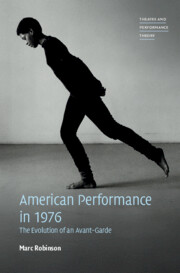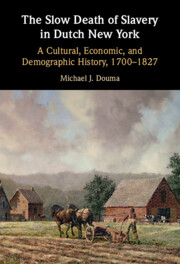Refine search
Actions for selected content:
91 results
Introduction
-
- Book:
- American Performance in 1976
- Published online:
- 27 November 2025
- Print publication:
- 11 December 2025, pp 1-43
-
- Chapter
-
- You have access
- HTML
- Export citation

American Performance in 1976
- The Evolution of an Avant-Garde
-
- Published online:
- 27 November 2025
- Print publication:
- 11 December 2025
Glyphosate- and atrazine-resistant Palmer amaranth in New York: Confirmation and Management with Alternative Postemergence Herbicides
-
- Journal:
- Weed Technology / Volume 39 / 2025
- Published online by Cambridge University Press:
- 24 November 2025, e115
-
- Article
-
- You have access
- Open access
- HTML
- Export citation
14 - Professional Speech, the Lochnerized First Amendment, and the Unauthorized Practice of Law
- from Part IV - New Frontiers
-
-
- Book:
- Rethinking the Lawyers' Monopoly
- Published online:
- 04 September 2025
- Print publication:
- 18 September 2025, pp 319-347
-
- Chapter
-
- You have access
- Open access
- HTML
- Export citation
4 - Cities and Coastal Flooding
-
- Book:
- Legacy in the Landscape
- Published online:
- 11 November 2025
- Print publication:
- 11 September 2025, pp 62-108
-
- Chapter
- Export citation
Community-Engaged Podcasting with Hidden Heroes in a Small Town
- Part of
-
- Journal:
- Public Humanities / Volume 1 / 2025
- Published online by Cambridge University Press:
- 03 September 2025, e132
-
- Article
-
- You have access
- Open access
- HTML
- Export citation
Chapter 34 - Boulez in North America
- from Part VI - At Home and Abroad
-
-
- Book:
- Boulez in Context
- Published online:
- 08 July 2025
- Print publication:
- 24 July 2025, pp 349-360
-
- Chapter
- Export citation
Chapter 11 - Anarchist Media, Cuba’s War for Independence, and the Forging of a Radical Transnational Latinidad, 1880s–1890s
- from Part III - Transgressing
-
-
- Book:
- Latinx Literature in Transition, 1444–1886
- Published online:
- 06 August 2025
- Print publication:
- 17 July 2025, pp 252-270
-
- Chapter
- Export citation
Chapter 22 - Garry Hynes
- from Part III - Collaborators and Critics
-
-
- Book:
- Sean O'Casey in Context
- Published online:
- 23 June 2025
- Print publication:
- 10 July 2025, pp 233-242
-
- Chapter
- Export citation
Chapter 12 - Race
- from Part II - Social Contexts
-
-
- Book:
- Sean O'Casey in Context
- Published online:
- 23 June 2025
- Print publication:
- 10 July 2025, pp 130-139
-
- Chapter
- Export citation
Chapter 27 - Onstage in the USA
- from Part IV - Performance Legacies
-
-
- Book:
- Sean O'Casey in Context
- Published online:
- 23 June 2025
- Print publication:
- 10 July 2025, pp 297-307
-
- Chapter
- Export citation
Chapter 19 - Eileen Carey (Eileen O’Casey)
- from Part III - Collaborators and Critics
-
-
- Book:
- Sean O'Casey in Context
- Published online:
- 23 June 2025
- Print publication:
- 10 July 2025, pp 202-211
-
- Chapter
- Export citation
Chapter 15 - Lyrical Mobilities
- from Part IV - Form
-
-
- Book:
- Latinx Literature in Transition, 1848–1992
- Published online:
- 10 April 2025
- Print publication:
- 17 April 2025, pp 260-276
-
- Chapter
- Export citation
Confirmation of glyphosate-resistant waterhemp (Amaranthus tuberculatus) in New York
-
- Journal:
- Weed Technology / Volume 39 / 2025
- Published online by Cambridge University Press:
- 13 January 2025, e28
-
- Article
-
- You have access
- Open access
- HTML
- Export citation
12 - The Real Gang History of New York
- from Part II - The Work Itself and Its Context
-
-
- Book:
- The Cambridge Companion to <i>West Side Story</i>
- Published online:
- 09 January 2025
- Print publication:
- 09 January 2025, pp 198-212
-
- Chapter
- Export citation

The Slow Death of Slavery in Dutch New York
- A Cultural, Economic, and Demographic History, 1700–1827
-
- Published online:
- 20 December 2024
- Print publication:
- 09 January 2025
1 - First Things
-
- Book:
- Steven Weinberg: A Life in Physics
- Published online:
- 22 November 2024
- Print publication:
- 12 December 2024, pp 1-2
-
- Chapter
-
- You have access
- HTML
- Export citation
4 - Follies and Frolics
-
- Book:
- Citizen Cowboy
- Published online:
- 16 August 2024
- Print publication:
- 29 August 2024, pp 79-102
-
- Chapter
- Export citation
Chapter 10 - The End of the Road
-
- Book:
- Bring Judgment Day
- Published online:
- 21 June 2024
- Print publication:
- 11 July 2024, pp 153-169
-
- Chapter
- Export citation
Chapter 3 - New York
- from Part I - Places
-
-
- Book:
- Robert Lowell In Context
- Published online:
- 28 March 2024
- Print publication:
- 04 April 2024, pp 31-40
-
- Chapter
- Export citation
